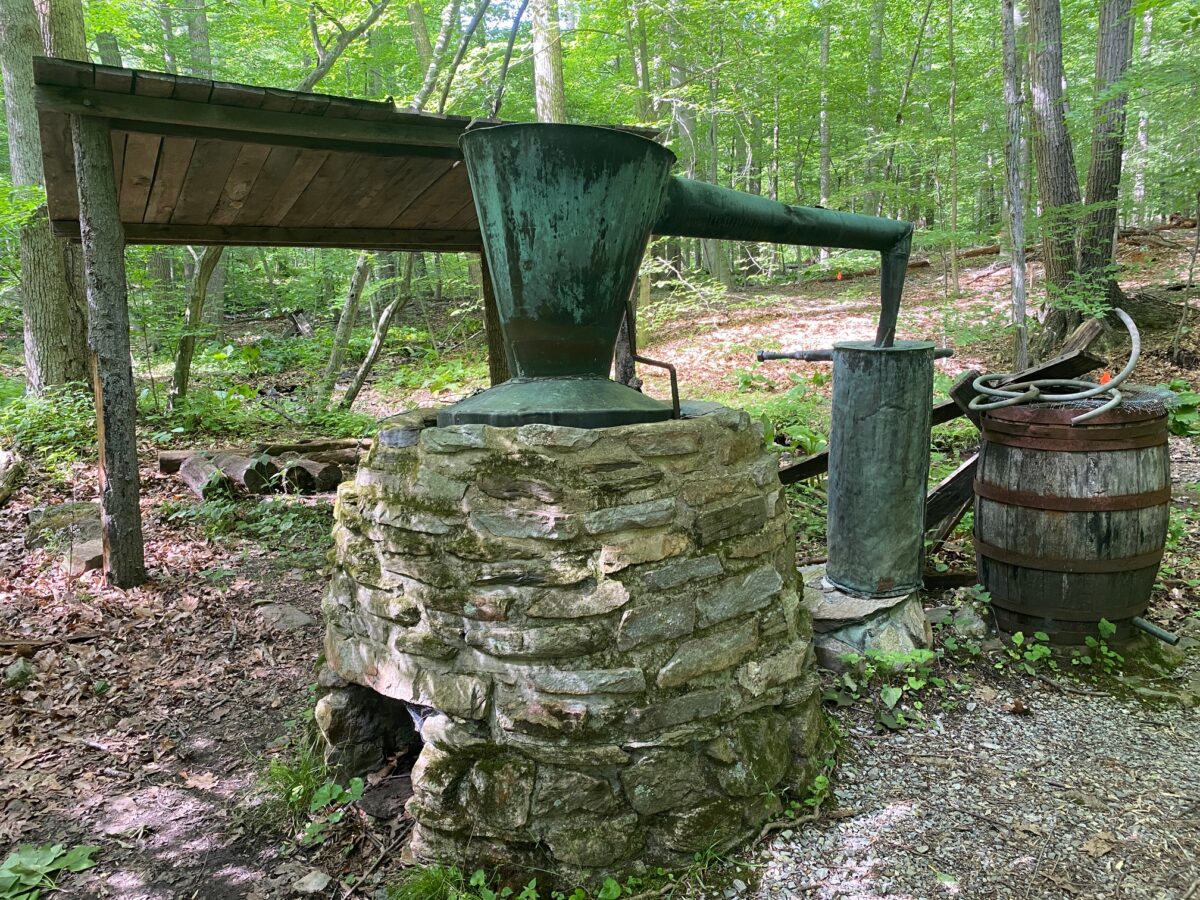Editor’s Note: It is a fact of life that many true stories have passed down through the ages parading as fiction. It is also true that many tall tales have been passed off as fact.
Take the story of Rip Van Winkle, for example, by early American author Washington Irving. If you read the after matter in this famous American story, you will see that an argument still ensues among the gentry of the Hudson Valley and the Katskill Mountains about what really happened to Rip when he disappeared all those twenty years. Did he really take one draught of the Dutchmen’s brew and sleep for twenty years? Or did he travel far away to escape the henpecking of Dame Van Winkle, and not come back home to his little village until she was dead and gone? It is a question we will never know the answer to, since all who knew the truth are now passed from this land forever.
You can still read this story for free online, since it is now in the public domain.
Rip Van Winkle, by Washington Irving
But there is still fun to be had from further speculations by the campfire. There are those who say old Rip had another infamous relative whose story was so secret that it was never written down. Having recently become the recipient of a leak that there might be a story out there about old Rip’s cousin Liam, I became enamored of the story and did my best to track it down. Here is what I learned. Keep in mind that this is just a first draft of the story published here just for fun. For how is one to savor life amongst all the bad news of the world without taking some time off from our troubles to speculate on an interesting story? They do it in the movies all the time. People have made great fortunes by making stories up, especially by stretching the truth for those who want to make believe in magic.
The Untold Story of Liam Van Winkle
By Wilson Ray –
Voyagers in the Mid-Atlantic region of the Eastern United States who travel with an open eye north of the great Potomac and Shenandoah Rivers where they come into confluence in a little corner of West Virginia, may have heard tale of the Katoctin Mountains, and the strange creatures who inhabit the enchanted forest there.
All know of the characters of the Appalachian range, from the foothills in Alabama, the misty Smokies in Tennessee, the layers of blue ridges in North Carolina and the Shenandoah in Virginia. The mountain folk created blue grass and country music, and some folks in Nashville made a fortune playing it on the radio and selling vinyl records.
Well if you keep traveling north you will traverse the easternmost peaks of the Blue Ridge Mountains, with giant rocks as old as the great Himalayas in China, yet worn down over millennia by the forces of Mother Nature to form a secret vista of their own.
Many have heard of the great Katskills even further north, where there once lived a man named Rip Van Winkle, who was lured into a mountain storm one night by Dutch gipsies and imbibed a local libation so tasty, strong and satisfying that he went to sleep as a loyal subject of King George III of England — and woke up 20 years later in a new country called the United States of America.
This is a popular tale published in its day by one of America’s first authors, Washington Irving, who borrowed some from his German and Swiss ancestors in telling the tale. Well it has been learned that there was to be another book telling the entire history of the Van Winkle family. Alas, Irving died in his house on the Hudson River in the state of New York before the manuscript could be completed. It was delayed by Irving’s painstaking work on the five volume history of his namesake, none other than George Washington himself, the dedicated hero who led the American revolutionaries against the king to establish a government of, by and for the people like the world had never seen.
If Irving had gotten around to it, he was going to most certainly talk of Rip’s infamous cousin Liam Van Winkle, who traveled the world over in his time but settled further south than Rip, in a scenic section of hidden woods in the Katoctins by two clear running streams. He carefully chose his spot by tasting the water, which he had done everywhere in all his travels in search of the perfect water for his special recipe.
When Rip had come back from his 20 year hiatus, he told the villagers of the elixir he had imbibed, and his much younger cousin Liam became fascinated by the story. He went searching for the Dutchmen playing ninepins in the woods where Rip had gone missing, but never heard them or found them there again. Perhaps his celestial timing was not the same as Rip’s.
Or perhaps the story Rip told the villagers was not entirely true. Maybe he went traveling all those years, and only came back after he heard Dame Van Winkle had finally passed. She was, to be sure, a woman who liked to complain a lot. Perhaps old Rip just got tired of hearing it and went away for awhile to take a break from it all. Or maybe he went off to war, and never talked about it when he got back because of what the horrors of war will do to a man.
While Liam never found the Dutchmen playing ninepins in the hills, it is said that he did once, in an out-of-the-way walk, discover the remnants of a still for making moonshine whiskey. Now being a mechanical sort of fellow, unlike his cousin, and much more ambitious to boot, Liam figured to profit from perfecting the concoction. Only it would not do to make it so strong that it would make a man sleep for 20 odd years.
Well that old Liam, it turns out, did cypher out the perfect recipe. In fact he did very well for himself at the distilling business, living a very long life in the peace and quiet of the enchanted forest, where most people were too afraid of the black bears to linger for longer than a fortnight or two. Only he had to remain hidden in the woods during the great Prohibition, so no one ever learned his name outside the fairies, midwives and courtesans of the Katoctins. In his day, Liam was only seen rarely in public in a brothel near the current location of the presidential retreat called Camp David, which is now a haunted house where children of all ages go for Halloween to be scared out of their britches.
Liam died a wealthy hermit somewhere around the vicinity of the peaks and valleys now known as Sabillasville, an unincorporated community in Frederick County, where even today the population remains quite low. The official census only shows 354 people to be living in the area, although that may be somewhat understandable since most of the enchanted forest along Owens Creek was set aside from development by the National Park Service in 1954. It is one of the last remaining places in the country where wild, native brook trout still swim in the cold water mountain streams, only you can’t catch them for eating. There are too few so they must be thrown back to spawn another day.
Not much more is known about Liam Van Winkle, although Irving is said to have come upon the journal of his world travels. Unfortunately it has never been found among his papers.
But one fine day, a park ranger exploring the woods near what is now the visitors center for the national park discovered all the parts of a whiskey still. A great restoration project was undertaken to bring it back to life as an exhibit in the park. You can still see it today. It’s only a quarter mile hike from the gravel parking lot. As you follow the creek upstream, look amongst the yellow, purple and white wildflowers for a farry watching you, or a big toad frog or an Indigo black snake, patrolling the park for timber rattlers.
What is known about the industry in the area in Liam’s day is that farmers of the Katoctin Mountain region faced problems in marketing the crops they grew, since the most profitable market for their goods lie many miles away in the more populated towns and cities like Baltimore. In the days before rail lines had been laid down and passable highways carved out of the mountainous landscape, the rugged terrain presented a barrier for horse-drawn wagons. Products such as grain, meat and lumber were too heavy to be transported to the more profitable markets. Corn and rye were also bulky. But when converted to whiskey, it became more easy to move, and more profitable to boot — under the light of the moon of course.
Conversion of rye and corn into liquor began in Frederick County with the harvest of the first crop, somewhere round about 1734, according to existing records, when many farms ran their own stills. That is until Congress passed the 1791 Excise Tax. For the next 128 years, it was legal to own a still — if you were willing to pay the tax. Not until the adoption of the Eighteenth Amendment to the Constitution in 1919 was possession of a whiskey still a criminal offense, when the great Prohibition commenced and stills were the target of sheriffs and “revenuers,” federal agents out to collect the tax, or bust up the still.
Unfortunately for the poorer mountain people, a hard working lot of farmers mainly of German and Swiss ancestry, the tax took the profit out of distilling crops and water into liquor. The concentration of rye and corn in spring water was the most practical way to get crops to market. So rather than pay the tax, they went underground, it is said, “operating by the light of the moon.”
While the average horse was capable of hauling only 4 bushels of corn at a time, the same horse could haul the equivalent of 24 bushels if the grain was manufactured into whiskey. The liquid whiskey occupied less space and was easier to carry to market. The price of whiskey depended on a number of factors. The better the grade of corn, the better the whiskey. The more plentiful and rich the spring water, the better the whiskey. Finally the more skilled the distiller, the finer the blend of whiskey.
Liam Van Winkle perfected the art and science and amassed a secret fortune.
But on July 31, 1929, Frederick County Deputy Sheriff Clyde L. Hauver was fatally wounded in a raid on the Blue Blazes Still. I swear this is all true. It was a large commercial operation, a “steamer” still, they called it. More than 25,000 gallons of mash was found in 13 vats, 2,000 gallons each. Local police eventually tracked down several suspects. Two moonshiners were convicted in connection with the murder after several days of conflicting testimony in the local courthouse.
Tales of a double-crossing informant, a love triangle, arson and other rumors spread throughout central Maryland and the Katoctin Mountains. What exactly happened remains a mystery to this day. Liam Van Winkle disappeared and was never seen or heard from again.
Today what could very well be his still sits on the banks of what is known as Distillery Run, between two creeks. The Blue Blazes still is typical of the smaller moonshine stills in the area, in Liam’s day. Rumor has it that the still found by that park ranger was Liam’s still. The location matches up.
Take a moment to imagine what it must have been like oh so many years ago, before suburban development turned the American landscape into a concrete and asphalt jungle with fast food joints on every corner. Imagine old Liam, and maybe his cousins Rip and Scotty down for a visit, sitting on a log by that creek, having themselves a smoke. They would be listening to the wood thrush song, same as today, and talking about politics and the weather, not so much the same. They would bide their time in the shade by the creek as they waited for the clean, scalding hot water to boil down the rye and corn into a mixture so strong it could make you hear and see the farries, and even talk back to them from time to time. That is when no one else was around to hear but the cottontail rabbits, the chipmunks and an old raccoon or a fox or two. Talking to the birds was not out of the question.
“Pretty birds,” you might say. “What are you chattering about today?”
Yep, magical things tend to happen in that enchanted forest, as the story goes. Just the peace and quiet alone can make you live longer, with less stress. Liam Van Winkle is said to have been nigh on 150 when he disappeared.
And who knows? If you ever venture there, you might even meet Cupid and fall in love. It’s been known to happen. Why there are couples with children coming back to these woods for peace and quiet for generations now, to experience the same glittering fire flies their grandparents still muse about in a nostalgic moment, when they’ve had a quieting draught or two of the good stuff.
If you ever get the chance to visit Liam’s woods, and sample his elixir, you will be glad you did. If you find yourself drifting off in a nap, talking to a spirit or a bunny rabbit on a fine spring or summer day, you will know you have made it in life to the place where Liam Van Winkle made his home and fortune. Maybe you can find a fortune of peace and quiet here too.















Good story.
Thanks, my friend.